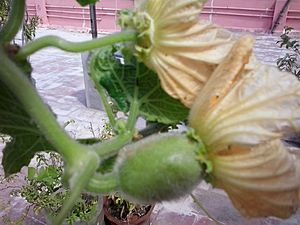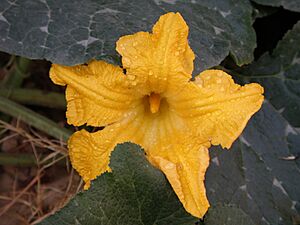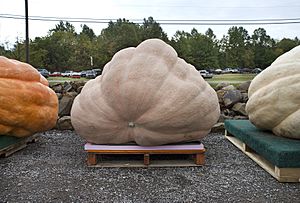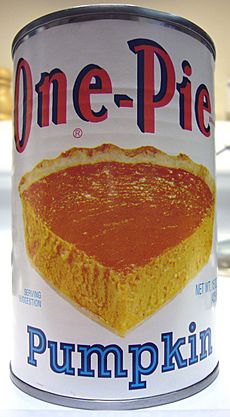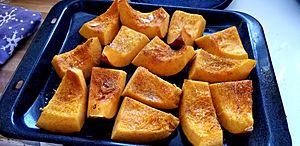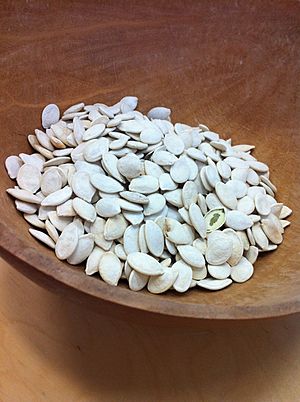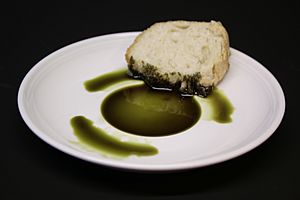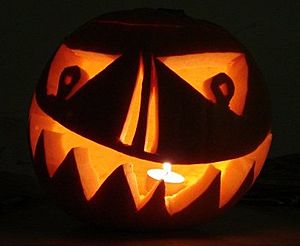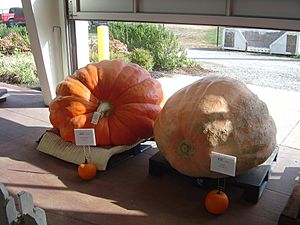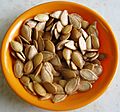Pumpkin facts for kids
Quick facts for kids Pumpkin |
|
|---|---|
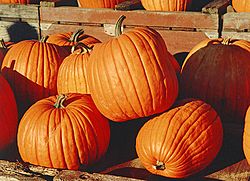 |
|
| Scientific classification | |
| Kingdom: | |
| Division: | |
| Class: | |
| Order: | |
| Family: | |
| Genus: |
Cucurbita spp.
|
| Species | |
A pumpkin is a type of gourd, which is a fruit with a hard rind. Pumpkins are usually bright orange, but you can also find them in white or other colors. They are typically round or slightly oval-shaped.
People enjoy eating pumpkins in many ways. They are often used to make delicious pies, especially around holidays. You can also eat and cook pumpkin seeds, which make a tasty snack. Besides food, pumpkins are popular for decorating, like when people carve them into jack-o'-lanterns for Halloween.
In countries like New Zealand and Australia, the word pumpkin often refers to a wider group of plants called winter squash.
Contents
What is a Pumpkin?
Pumpkins are a type of squash. They first grew in northeastern Mexico and the southern United States. Scientists have found pumpkin pieces in Mexico that are between 7,000 and 5,500 years old! Pumpkin fruits are a special kind of berry called a pepo.
Most pumpkins, like the ones used for carving, weigh between 6 and 18 pounds (about 3 to 8 kilograms). However, some special types of pumpkins, called "giant pumpkins," can grow to be much, much heavier, sometimes over 75 pounds (34 kilograms)!
The bright orange color of pumpkins comes from natural pigments called carotenoids. These include beta-cryptoxanthin, alpha carotene, and beta carotene. Your body can turn these into vitamin A, which is important for good eyesight and a healthy immune system.
Types of Pumpkins
All pumpkins are considered winter squash. This means they are mature fruits from certain species in the plant group Cucurbita. What makes a "pumpkin" a pumpkin usually includes its smooth, slightly ribbed skin and its deep yellow to orange color.
Around 2005, white pumpkins became very popular in the United States. You can also find pumpkins in other colors, like dark green, which are sometimes grown for their seeds to make oil.
How Pumpkins Grow
Pumpkins are grown all over the world for many reasons. Farmers grow them for animal feed, and people buy them for cooking or decorating. The only continent that can't grow pumpkins is Antarctica because it's too cold! The classic American pumpkin used for jack-o'-lanterns is called the Connecticut Field variety.
Planting and Caring for Pumpkins
To grow a pumpkin, first pick the right type. Some are small for pies, while others are huge for carving. Pumpkins like soil that drains well and is rich in nutrients, with a pH between 6.0 and 6.8. You can add compost to make the soil better.
- Plant pumpkin seeds when the soil is warm enough, at least 70°F (21°C).
- Make small hills or mounds about 6-8 feet (1.8-2.4 meters) apart.
- Plant 4-5 seeds in each hill, about 1 inch (2.5 cm) deep.
- Water the soil gently after planting.
- Keep the soil moist, but don't let it get soggy. Try to water the base of the plant to avoid fungal diseases.
- When the young plants are about 2 inches (5 cm) tall, thin them out. This means removing the weaker plants and leaving the two strongest ones per hill.
- Add mulch around the plants. This helps the soil stay moist and stops weeds from growing.
- Give your plants fertilizer when they start to grow long vines.
- Pinch off the tips of the vines when they are 10-15 feet (3-4.5 meters) long. This helps the plant focus its energy on growing fruit.
- Bees and other insects are important for pollinating pumpkin flowers. If there aren't enough bees, you might need to help by moving pollen from male flowers to female flowers yourself.
- Pumpkins are ready to pick when they have their full color and their skin feels hard.
Where Pumpkins are Grown
| Pumpkin Production – 2017 |
|
|---|---|
| Country | (millions of tonnes) |
|
|
|
|
|
|
|
|
|
|
|
|
|
|
|
|
|
|
|
|
|
In 2017, the world produced about 27 million tonnes of pumpkins (this includes other squash and gourds). China and India grew almost half of all pumpkins worldwide. Russia, Ukraine, and the United States each produced about one million tonnes.
Pumpkins in the United States
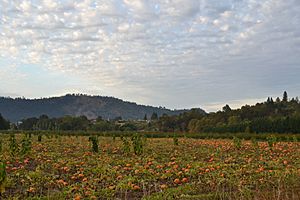
Pumpkins are a very popular crop in the United States. In 2017, over 1.5 billion pounds (about 680 million kilograms) of pumpkins were grown! The top pumpkin-producing states are Illinois, Indiana, Ohio, Pennsylvania, and California.
Most of the pumpkins grown in the U.S. that are used for processing (like making pumpkin purée for pies) come from Illinois. A company called Nestlé, under the brand Libby's, makes 85% of the processed pumpkin in the United States at its factory in Morton, Illinois.
Pumpkins need warm weather to grow well and are usually planted in early July. The soil needs to be at least 60°F (15.5°C) and hold water well. Pumpkins can be damaged by cold temperatures or if they don't get enough water. However, they are quite strong plants. Even if some leaves are removed, the plant can quickly grow new vines.
Pumpkins have both male and female flowers. They need to be fertilized, usually by bees, to grow fruit. Bees like the native squash bee and eastern bumblebee are great at pollinating pumpkins. Many commercial farms use honeybee hives to help with pollination. If there aren't enough bees, gardeners sometimes have to hand pollinate the flowers themselves.
Giant Pumpkins
"Giant pumpkins" are a special type of large squash that can weigh over 1 tonne (1,000 kilograms)! These huge pumpkins come from large squash varieties found in South America. Farmers and plant societies have worked hard to grow them even bigger for competitions.
Pumpkin Nutrition
| Nutritional value per 100 g (3.5 oz) | |
|---|---|
| Energy | 109 kJ (26 kcal) |
|
6.5 g
|
|
| Sugars | 2.76 g |
| Dietary fiber | 0.5 g |
|
0.1 g
|
|
|
Protein
|
1 g
|
| Vitamins | Quantity
%DV†
|
| Vitamin A equiv.
beta-Carotene
lutein zeaxanthin
|
53%
426 μg
29%
3100 μg1500 μg
|
| Thiamine (B1) |
4%
0.05 mg |
| Riboflavin (B2) |
9%
0.11 mg |
| Niacin (B3) |
4%
0.6 mg |
| Pantothenic acid (B5) |
6%
0.298 mg |
| Vitamin B6 |
5%
0.061 mg |
| Folate (B9) |
4%
16 μg |
| Vitamin C |
11%
9 mg |
| Vitamin E |
3%
0.44 mg |
| Vitamin K |
1%
1.1 μg |
| Minerals | Quantity
%DV†
|
| Calcium |
2%
21 mg |
| Iron |
6%
0.8 mg |
| Magnesium |
3%
12 mg |
| Manganese |
6%
0.125 mg |
| Phosphorus |
6%
44 mg |
| Potassium |
11%
340 mg |
| Sodium |
0%
1 mg |
| Zinc |
3%
0.32 mg |
| Other constituents | Quantity |
| Water | 91.6 g |
|
Full Link to USDA Database entry
|
|
| †Percentages estimated using US recommendations for adults. | |
A 100-gram serving of raw pumpkin has about 26 calories. It's an excellent source of beta-carotene and vitamin A, which are important for your health. It also has some Vitamin C. Pumpkins are mostly water (92%), with some carbohydrates (6.5%), a little fat (0.1%), and some protein (1%).
How We Use Pumpkins
Cooking with Pumpkins
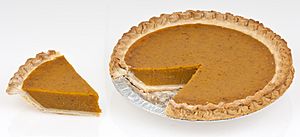
Pumpkins are super versatile in the kitchen! Most parts of the pumpkin are edible, including the fleshy part, the seeds, the leaves, and even the flowers. In the United States and Canada, pumpkin is a popular food for Halloween and Thanksgiving. Many people make pumpkin purée and freeze it to use later.
When a pumpkin is ripe, you can boil it, steam it, or roast it. In North America, pumpkins are a very important part of the autumn harvest. They are often eaten mashed or used in soups. Pumpkin pie is a traditional dish for Canadian and American Thanksgiving holidays. In many countries, like Canada, Mexico, the United States, Europe, and China, the seeds are often roasted and eaten as a snack.
Small, green pumpkins can be eaten like other squash or zucchini. In the Middle East, pumpkin is used for sweet dishes, like halawa yaqtin. In India, pumpkin is cooked with butter, sugar, and spices in a dish called kadu ka halwa. In Japan, small pumpkins are served in savory dishes, like tempura. In Thailand, small pumpkins are steamed with custard inside and served as a dessert. In Vietnam, pumpkins are often cooked in soups with pork or shrimp. In Italy, pumpkin can be used with cheeses as a savory filling for ravioli. You can also use pumpkin to flavor drinks.
In the southwestern United States and Mexico, pumpkin and squash flowers are a popular food. They can be used to decorate dishes, or dipped in batter and fried. Pumpkin leaves are also eaten as a vegetable in places like Kenya and Zambia.
Sometimes, canned "pumpkin" purée or pumpkin pie filling might contain other types of winter squash, like butternut squash.
Pumpkin Leaves
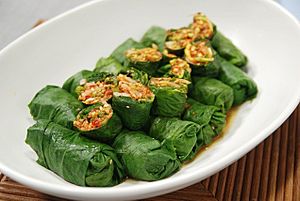
The leaves of some pumpkin varieties, especially C. moschata, are eaten as a vegetable in Korean cuisine. In parts of India, people make dishes like saag and kachri/pakoda from the leaves and flowers.
Pumpkin Seeds
Pumpkin seeds, also called pepitas, are edible and full of nutrients. They are about 0.5 inches (1.5 cm) long, flat, and light green. They usually have a white husk, but some pumpkin types grow seeds without husks. Pumpkin seeds are a popular snack and can be found at most grocery stores. They are a good source of protein, magnesium, copper, and zinc.
Pumpkin Seed Oil
Pumpkin seed oil is a thick oil made by pressing roasted pumpkin seeds. It can look red or green depending on how thick the oil layer is. When used for cooking or as a salad dressing, it's often mixed with other oils because it has a strong flavor. Pumpkin seed oil contains healthy fatty acids.
Other Uses for Pumpkins
Veterinarians sometimes suggest canned pumpkin as a food supplement for dogs and cats with tummy troubles like constipation or diarrhea. The high fiber in pumpkin helps with digestion.
Raw pumpkin can also be fed to chickens and other poultry in the winter. It helps them keep laying eggs when it's cold.
Historically, Native Americans used pumpkins for health purposes, like helping with intestinal worms. In some parts of Europe and China, pumpkin seeds were also used in traditional medicine for similar reasons.
Pumpkins in Culture
Halloween and Jack-o'-lanterns
Pumpkins are famously carved into decorative lanterns called jack-o'-lanterns for the Halloween season. This tradition started in Britain and Ireland, where people originally carved lanterns from vegetables like turnips or swedes. When Irish immigrants came to North America, they started using pumpkins because they were easy to find and much larger, making them easier to carve.
The term jack-o'-lantern for a carved vegetable lantern first appeared in 1837. By 1866, carved pumpkin lanterns were strongly linked to Halloween. In the United States, the carved pumpkin was first connected to the harvest season in general, even before it became a Halloween symbol.
Pumpkins are also strongly linked to harvest time and pumpkin pie at Canadian and American Thanksgiving. This connection has led to many pumpkin-flavored food products, like the popular pumpkin spice latte. Interestingly, most North Americans buy whole pumpkins mainly for carving, not usually for eating. Sarah Frey, known as "the Pumpkin Queen of America," sells about five million pumpkins each year, mostly for jack-o'-lanterns.
Pumpkin Chunking
Pumpkin chunking is a fun competition where teams build machines to throw a pumpkin as far as they can! They use devices like Catapults, trebuchets, and air cannons. Some pumpkin chunkers even grow special pumpkins just for throwing, hoping they will survive the launch.
Pumpkin Festivals and Competitions
"Giant pumpkins" are huge orange versions of the Cucurbita maxima squash. Growers often compete to see who can grow the heaviest pumpkin. Many festivals are held to celebrate pumpkins and these amazing competitions.
The world record for the heaviest pumpkin was set in Belgium in 2016. That pumpkin weighed an incredible 2,624.6 pounds (1,190.5 kilograms)! In the United States, the town of Half Moon Bay, California, hosts an annual Half Moon Bay Art and Pumpkin Festival that includes a World Champion Pumpkin Weigh-Off.
Pumpkins in Stories
Pumpkins often appear in old stories and popular culture, sometimes linked to magic or spooky things:
- In some tales, witches can turn people into pumpkins.
- The idea of jack-o'-lanterns comes from Halloween folklore about keeping away imaginary demons.
- In the famous folk tale Cinderella, a fairy godmother turns a pumpkin into a carriage, but it changes back at midnight.
- In some versions of The Legend of Sleepy Hollow, the headless horseman uses a pumpkin as a substitute head.
Images for kids
See also
 In Spanish: Calabaza gigante para niños
In Spanish: Calabaza gigante para niños


